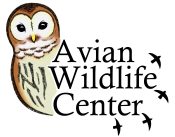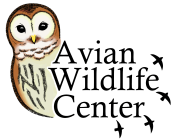Injured Bird
We recommend calling first for advice on what to do: (973) 702-1957. Consider your safety as well as the bird’s. Avoid picking up a wild bird in your bare hands. Do not approach larger predatory birds (hawks, owls, herons, loons, etc.) until you have spoken with a licensed animal rescuer.
If you have determined that the bird needs help, get it safely contained in a box. Put a box or cloth over the bird and move to a box with a cloth on the bottom to cushion the bird. Close or cover the box. A plastic pet carrier can be used, but never put a wild bird in a wire cage.
Do not force food or any liquid into the bird. This could stress the bird and worsen its condition. Phone immediately. The sooner the bird receives the proper treatment the better the chances are for a recovery.
Nestlings and Young
Never assume a young bird found on the ground is an orphan or has been “thrown out” by its parents. Often it has fallen from the safety of the nest by accident. The best thing to do is make sure the nestling is not injured and return it to the family. It is a myth that the parents will reject it after smelling the human scent. They will accept the young bird returned to the nest.
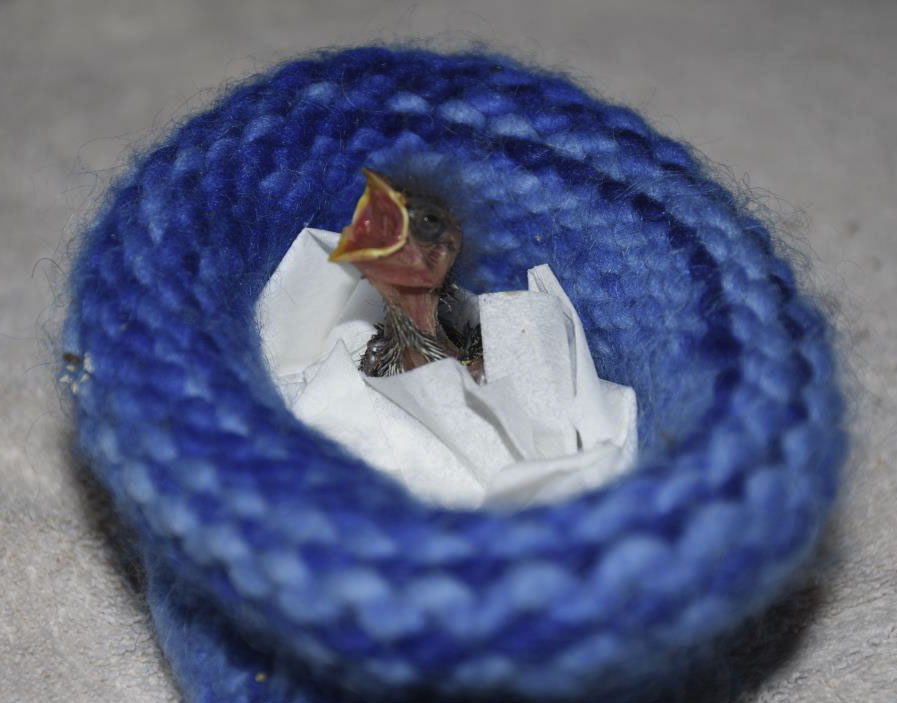 An altricial nestling with sparse down feathers or bare skin is one that needs to be returned to a nest. If the nestling is weak or injured, improvise a nest out of tissues or cloth bunched around the bird. Warmth can be provided with a hot water bottle or uncooked rice heated in the microwave and placed in a sock near the bird. The nestling should feel warm to the touch. Do not give the nestling any liquids. It is easy to drown a young bird that way. Phone a licensed rehabilitator immediately.
An altricial nestling with sparse down feathers or bare skin is one that needs to be returned to a nest. If the nestling is weak or injured, improvise a nest out of tissues or cloth bunched around the bird. Warmth can be provided with a hot water bottle or uncooked rice heated in the microwave and placed in a sock near the bird. The nestling should feel warm to the touch. Do not give the nestling any liquids. It is easy to drown a young bird that way. Phone a licensed rehabilitator immediately.
Young birds that are fully covered with feathers and can walk well do not need to go back in a nest. The bird has fledged from the nest. Some fledglings are not able to fly at first. (Robins are an example.) You can try to direct the fledgling into a bush where it will be better hidden from dangers. The parents will find it by hearing its call. However, if the young bird a duckling, gosling, killdeer, or turkey see the next section on precocial young.
Ducklings and other Precocial Young**
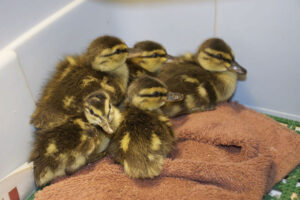 If one or more ducklings or precocial chicks are seen with no mother in sight, they need to be rescued immediately. Young of some species are able to walk soon after hatching and follow the mother. In the process of going from nest to feeding areas, they can get separated. If they cannot hear each other, young can be left behind and need rescuing. Observe from a distance to make certain the mother is not in the area.
If one or more ducklings or precocial chicks are seen with no mother in sight, they need to be rescued immediately. Young of some species are able to walk soon after hatching and follow the mother. In the process of going from nest to feeding areas, they can get separated. If they cannot hear each other, young can be left behind and need rescuing. Observe from a distance to make certain the mother is not in the area.
Lost young should be nestled on a towel in a box. Contact the Avian Wildlife Center or another licensed rehabilitator immediately. Hours can make a difference as to whether they will survive.
Another species with precocial young is the killdeer. This bird often nests on the ground or on a flat roof in amongst stones. Young may be found feeding near parking lots, playgrounds, and other unnatural areas. Careful observation often reveals the mother is nearby. She feigns a broken wing to distract you from her young, but will fly if you follow her.
**Precocial young are covered with a full coat of down feathers at hatching. Their eyes are open. They are able to walk soon after hatching and follow the mother to feed.
Hummingbirds
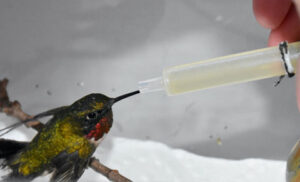 If you come across a hummingbird that is not flying, you need to contact us immediately for instructions. Being small with a fast metabolism means they cannot go without food for very long. You can place it in a box with a bunched cloth to support it. If you have flowers blooming that attract hummingbirds, try placing the flower directly in front of the bird’s bill. You can prepare a sugar-water solution by using regular table sugar and water. Measure 4 parts water and warm on the stove, add 1 part sugar (ex. 1 cup water and ¼ cup sugar) and stir until it dissolves completely. Remove from heat, allow to cool to room temperature. Draw up in a clean dropper or syringe and position the dropper at the tip of the hummingbird’s bill. Do not squeeze any liquid out, but let the bird drink on its own. You will see the tongue licks the sugar water. It is vital that you do not get any liquid on the bird.
If you come across a hummingbird that is not flying, you need to contact us immediately for instructions. Being small with a fast metabolism means they cannot go without food for very long. You can place it in a box with a bunched cloth to support it. If you have flowers blooming that attract hummingbirds, try placing the flower directly in front of the bird’s bill. You can prepare a sugar-water solution by using regular table sugar and water. Measure 4 parts water and warm on the stove, add 1 part sugar (ex. 1 cup water and ¼ cup sugar) and stir until it dissolves completely. Remove from heat, allow to cool to room temperature. Draw up in a clean dropper or syringe and position the dropper at the tip of the hummingbird’s bill. Do not squeeze any liquid out, but let the bird drink on its own. You will see the tongue licks the sugar water. It is vital that you do not get any liquid on the bird.
Bring the bird as quickly as possible to the nearest avian rehabilitator for care.
